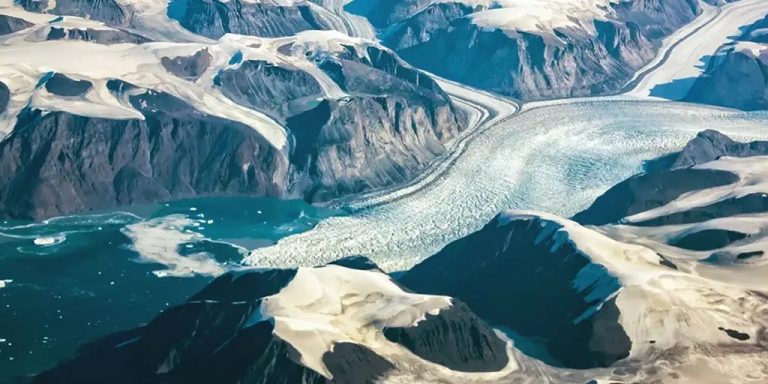from climate etc.
Author: Dan Hughes
This article challenges traditional frameworks for modeling meltwater flow in glaciers and ice sheets.
Increased melting rates due to potential increases in temperatures would allow liquid water to flow directly into the ocean. Another aspect is that when the meltwater reaches the bottom of the glacier, it may cause increased glacier sliding and eventually lead to glacier calving.
The World Resources Institute (WRI) summarizes the IPCC AR6 results on ice melt in Greenland and Antarctica:
For example, if temperatures rise to 2 degrees Celsius (3.6 degrees Fahrenheit) to 3 degrees Celsius (5.4 degrees Fahrenheit), the ice sheets in West Antarctica and Greenland could melt almost completely and irreversibly over thousands of years, causing sea levels to rise. A few meters.
| temperature rise | 1.5 degrees Celsius (2.7 degrees Fahrenheit) | 2.0 degrees Celsius (3.6 degrees Fahrenheit) | 3.0 degrees Celsius (5.4 degrees Fahrenheit) |
| Global mean sea level will rise by 2100 | 0.28 – 0.55 m(0.92 – 1.80 feet) | 0.33 – 0.61 m(1.08 – 2.00 feet) | 0.44 – 0.76 m(1.44 – 2.40 feet) |
The flow of meltwater on and with glaciers and other ice sheets is important relative to the addition of liquid water to Earth's oceans and the overall movement of glaciers and ice sheets. Glacier meltwater may flow along the surface like a stream or river, accumulate in surface lakes, flow down open crevasses or moulins, and accumulate as lakes within the ice mass as a layer of liquid between the ice bottom and bedrock. Flow, or flow enclosed in a channel partially or completely embedded within an ice mass.
Flows reaching the ice sheet boundary deplete the ice mass balance and may contribute to sea level rise if the flow reaches the ocean. Meltwater remaining on the surface of a glacier or ice sheet can refreeze without affecting the glacier mass balance. The flow of water through crevasses and moulins to the base of the glacier is thought to provide potential lubrication and flotation, thereby enhancing the movement of the ice.
How strong is the basis for glacial melt flow modeling included in ice sheet melt projections?
Thermal hydrodynamic models have been used to simulate glacier melt flow for more than four decades. The widely used Springer-Hutton formula is based on the principles of continuum mechanics and a detailed mathematical simplification of the standard one-dimensional channel average form for engineering applications. Steady-state energy balance equations apply to liquid water flow in ice channels embedded in large ice blocks. The Spring-Hutter system takes into account the evolution of channel circulation area in time and space. Changes in flow area are caused by ice melt and the dynamics of the ice in which the channel is located. There has been a lot of research on clarifying, modifying, and applying the Spring-Sutter framework.
new paper
I provide a detailed analysis of the Spring-Sutter equation and its solution in this paper [EDHmelt]
This paper clarifies and improves calculations of the role of viscous dissipation of kinetic energy into thermal energy as this physical process occurs in models of melt flow embedded at the boundaries of glaciers and ice sheets.
The flow of meltwater on and within glaciers and other ice sheets is important for adding liquid water to Earth's oceans and for the overall movement of glaciers and ice sheets. Glacier meltwater may flow along the surface like a stream or river, accumulate in surface lakes, flow down open crevasses or moulins, and accumulate as lakes within the ice mass as a layer of liquid between the ice bottom and bedrock. Flow, or flow enclosed in a channel partially or completely embedded within an ice mass.
Flows reaching the ice sheet boundary deplete the ice mass balance and may contribute to sea level rise if the flow reaches the ocean. Meltwater remaining on the surface of a glacier or ice sheet can refreeze without affecting the glacier mass balance. The flow of water through crevasses and moulins to the base of the glacier is thought to provide potential lubrication and flotation, thereby enhancing the movement of the ice.
A dimensionless form of the steady-state energy balance of liquids is developed and solved, taking into account the effect of meltwater on bulk liquids. An analytical solution for the temperature distribution along the channel is developed. These solutions clearly illustrate the effects of the viscous dissipation of kinetic energy into heat and on the melting of ice at the liquid-ice interface.
The paper shows:
- It is incorrect to allow viscous dissipation of kinetic energy directly into melting
- The energy equations are incomplete because they do not take into account melt water entering the bulk liquid
- Spring-Hutter's explanation of melt water entering a bulk liquid is incorrect.
Relevant
